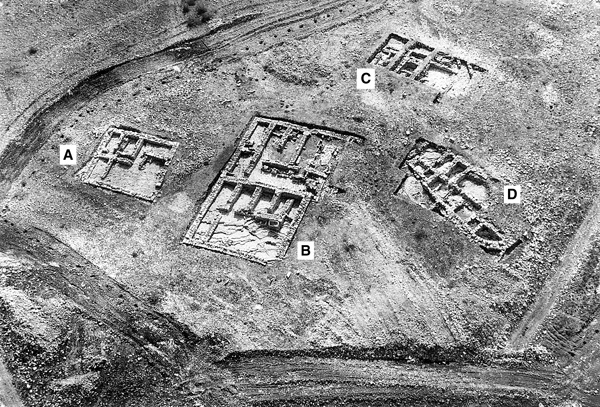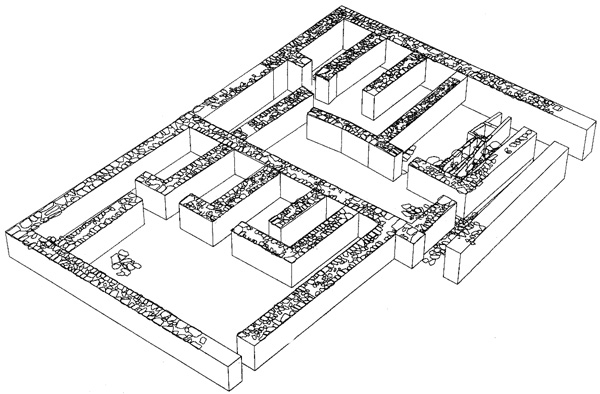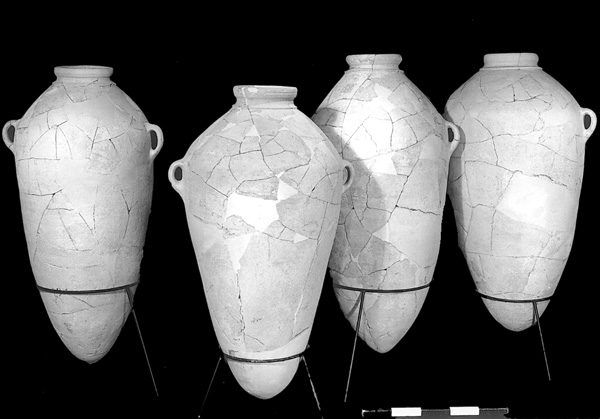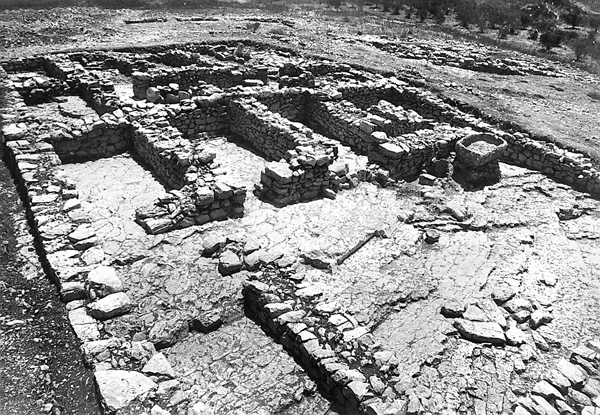‘En Ḥaggit
INTRODUCTION
‘En
EXCAVATION RESULTS
THE MIDDLE BRONZE AGE IIC. One of the few examples of an excavated enclosed rural site from the Middle Bronze Age IIC was revealed, including a series of domestic rooms and portions of a 1.7 m-wide enclosure wall (in areas C and D). Finds of special interest include a jar handle bearing the impression of a Hyksos scarab, a fragment of Tell el-Yahudiyeh ware, several fragments of Cypriot red-on-black ware, and a fragment of a potter’s wheel. The economy of this small rural site was based on agriculture supplemented by animal husbandry, including significant swine-herding activity. Sheep and goat comprised 53 percent of the total faunal assemblage, cattle 24 percent, and pig 20 percent.
THE LATE BRONZE AGE IIA. A gap in occupation was punctuated by a Late Bronze Age burial from area C containing 15 complete vessels (including nine Cypriot base-ring I and II pieces).

THE IRON AGE I. The site was reoccupied in the Iron Age I (eleventh century BCE, according to the traditional chronology, or early or mid-tenth century BCE, according to the low chronology; contemporary with Megiddo stratum VIA, Jokneam stratum XVII, Qiri stratum VIII, Dor phase 8 in area G and phases 11–10 in area B, and Tell Keisan stratum IX). Architectural remains were preserved in all four areas of excavation. The most impressive architectural remains, found in area B, consist of two units (measuring a total of c. 30 by 17 m) sharing a common wall but no common entrance. Each unit has a courtyard with a long room at its far end, and a series of rooms with entrances from the courtyard. One room contained several smashed collared-rim pithoi. Two ovens were found in the courtyard; one made from a portion of the body of a collared-rim pithos, the other consisting of an upside-down collared-rim pithos (lacking its upper part) surrounded by limestone slabs. In area A, an additional complex (14 by 13 m) was exposed, similar in plan to the units in area B. The plan and construction of these complexes—rooms with off-centered entrances and walls built in header-stretcher technique employing rough ashlar masonry—are distinguishable from those found in contemporary central highland sites, and find parallels at Megiddo building 2072 and Tell Keisan; thus, this may be considered a local Canaanite/Phoenician architectural style.

Two components can be discerned among the ceramics of this phase, one which is for the most part identical to that found in hill-country sites (flanged-rim cooking pots, collared-rim pithoi, and multi-handled kraters), and one represented by decorated flasks, painted “Canaanite” storage jars, and “Northern skyphoi,” interpreted as a northern coastal component. Politically, the site may have been part of the region of Dor.

As in the Middle Bronze Age, the subsistence economy in the Iron Age I was based on agriculture supplemented by animal husbandry. Percentages of species shifted, however. Cattle remained constant (20 percent), but sheep and goat increased dramatically to 72 percent, while pigs almost disappeared altogether. This change is interpreted as a shift in preferences for different kinds of meat rather than a reflection of environmental or ethno-cultural change. The site probably functioned as a Canaanite farmstead (note the dozens of basalt grinding implements and animal husbandry typical of an agricultural community), although functions such as a caravansary, serving travelers sojourning between Dor and Jokneam, and/or a regional distribution center cannot be discounted.

THE LATER PERIODS. A minor Iron Age II (eighth/seventh centuries BCE) presence, most likely related to a site located 1 km to the south (excavated in 2005 by G. Finkielsztejn and A. Gorzalczany), and an even smaller Early Roman period presence, probably related to the Roman site of
SAMUEL WOLFF
INTRODUCTION
‘En
EXCAVATION RESULTS
THE MIDDLE BRONZE AGE IIC. One of the few examples of an excavated enclosed rural site from the Middle Bronze Age IIC was revealed, including a series of domestic rooms and portions of a 1.7 m-wide enclosure wall (in areas C and D). Finds of special interest include a jar handle bearing the impression of a Hyksos scarab, a fragment of Tell el-Yahudiyeh ware, several fragments of Cypriot red-on-black ware, and a fragment of a potter’s wheel. The economy of this small rural site was based on agriculture supplemented by animal husbandry, including significant swine-herding activity. Sheep and goat comprised 53 percent of the total faunal assemblage, cattle 24 percent, and pig 20 percent.
